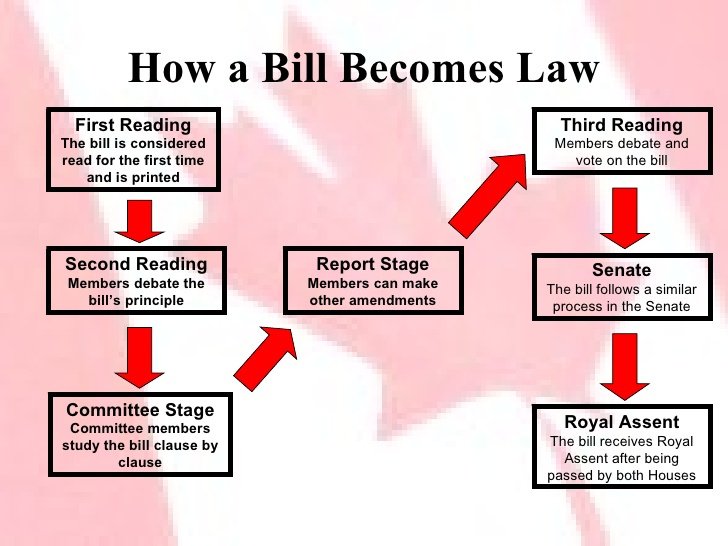- Creating laws in Canada requires many different steps:
- First Reading
- Second Reading
- Parliamentary Committee
- Report Stage
- Third reading
- Royal Assent
First Reading
- Any idea for a new law or a change to current law is written down.
- The idea is now called a bill.
- The bill is printed and read in the House it is starting from.
- If a bill originates in the Senate, the bill is identified with the letter S and given a number; for example, Bill S-4.
- If a Bill originates in the House of Commons, it is identified with the letter C and given a number; for example, Bill C-78.
Second Reading
- The bill is given a Second Reading in the House it is starting from (Senate or HOC).
- Parliament officials (senators or MPs) debate the idea behind the bill.
- They consider questions such as:
- “Is the idea behind the bill good?”
- “Does it meet people’s needs?”
- “Who will be affected by this bill?”
- If the House votes for the bill and it passes this stage, it goes to a committee of the House, which usually meets in a smaller committee room outside the Chamber.
Parliamentary Committee
- The bill is studied carefully.
- Hearings or special meetings are held where different people inside and outside government can make comments about the bill.
- The committee can ask for government officials and experts, or witnesses, to come and answer questions.
- The committee can suggest changes or amendments to the bill when it gives its report to the House.
Report Stage
- The committee reports the bill back to the House along with recommended changes.
- All parliamentarians can then debate it.
- Those who were not part of the committee that studied the bill can suggest changes to the bill.
Third Reading
- The parliamentarians debate it again!
- Sometimes they can change their minds about a bill if they do not like the changes made by the Parliamentary Committee
- If it passes Third Reading, the bill then goes to the other House where it goes through the same stages (First / Second / PC / RS / Third Reading).
Royal Assent
- Once both the Senate and the House of Commons have passed the bill in exactly the same wording, it is given to the Governor General (or his or her appointed representative) for Royal Assent (final approval), and it can become law.
- During the ceremony to receive Royal Assent, bills that have to do with taxes and financial matters are tied with a green ribbon; all others are tied with a red one.



No comments:
Post a Comment